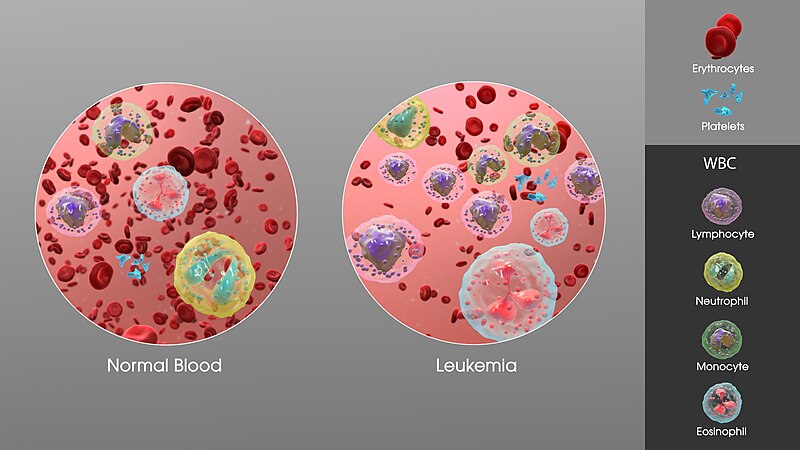Leukaemia
Leukaemia is a group of blood cancers originating in the bone marrow, characterized by the overproduction of abnormal white blood cells called blasts or leukaemia cells. These immature cells crowd out normal cells, leading to symptoms such as bleeding, bruising, bone pain, fatigue, fever, and increased susceptibility to infections. The condition is typically diagnosed through blood tests and bone marrow biopsy.

Classification
Leukaemia is divided into acute and chronic forms, further classified by the type of blood cell involved—lymphocytic or myelogenous.
- Acute Leukaemia: Rapid increase in immature blood cells necessitating immediate treatment. Common in children.
- Chronic Leukaemia: Slow buildup of relatively mature, abnormal white blood cells. Often monitored before treatment. Common in older adults.
Types of Leukaemia:
- Acute Lymphoblastic Leukaemia (ALL)
- Chronic Lymphocytic Leukaemia (CLL)
- Acute Myelogenous Leukaemia (AML)
- Chronic Myelogenous Leukaemia (CML)
- Other rare types include Hairy Cell Leukaemia (HCL) and T-cell Prolymphocytic Leukaemia (T-PLL).
Signs and Symptoms
Common symptoms include easy bruising, pale skin, fever, and an enlarged spleen or liver in children. The displacement of normal bone marrow cells by leukaemia cells results in low blood platelet count, causing excessive bleeding and bruising. Dysfunctional white blood cells weaken the immune system, leading to frequent infections. Red blood cell deficiency causes anaemia, leading to dyspnea and pallor. Some patients may experience neurological symptoms if leukaemic cells invade the central nervous system.

Causes
Leukaemia results from mutations in the DNA, which can be triggered by genetic factors, environmental exposures, or a combination of both. Known risk factors include smoking, ionising radiation, exposure to chemicals like benzene, previous chemotherapy, and genetic conditions such as Down syndrome.
Diagnosis
Diagnosis involves repeated complete blood counts and a bone marrow examination. Imaging tests like X-rays, MRI, or ultrasounds may be used to evaluate the extent of the disease. Blood chemistry tests help determine liver and kidney damage or the effects of chemotherapy.

Treatment
Treatment varies based on the type of leukaemia and patient age. Common treatments include chemotherapy, radiation therapy, targeted therapy, and bone marrow transplant.
Acute Lymphoblastic Leukaemia (ALL)
Treatment involves several phases: induction chemotherapy to induce remission, consolidation therapy to eliminate remaining leukaemia cells, CNS prophylaxis to prevent spread to the brain, and maintenance therapy to prevent recurrence. High-risk or relapsed patients may undergo allogeneic bone marrow transplantation.
Chronic Lymphocytic Leukaemia (CLL)
Treatment is based on disease stage and symptoms. Initial treatment often involves combination chemotherapy with corticosteroids. Advanced cases may require nucleoside drugs or bone marrow transplantation.
Acute Myelogenous Leukaemia (AML)
Treatment involves combination chemotherapy for induction, followed by consolidation and maintenance treatment to prevent recurrence. Specific treatments may vary based on age and AML subtype.
Chronic Myelogenous Leukaemia (CML)
Imatinib (Gleevec) is the standard treatment, achieving over 90% five-year survival. Advanced cases may require allogeneic bone marrow transplantation.
Hairy Cell Leukaemia (HCL)
Treatment is initiated based on symptoms and typically involves cladribine or pentostatin. Other options include rituximab and Interferon-alpha.
T-cell Prolymphocytic Leukaemia (T-PLL)
This aggressive leukaemia requires immediate treatment, often involving alemtuzumab or stem cell transplantation.
Prognosis
The prognosis depends on the type of leukaemia, patient age, and response to treatment. The five-year survival rate in the United States is approximately 65%, with better outcomes in children due to more effective treatments.

Epidemiology
In 2010, about 281,500 people globally died from leukaemia. It is more common in developed countries and is the most frequent cancer in children. In the UK, leukaemia is the eleventh most common cancer and the ninth most common cause of cancer death.

Self-assessment MCQs (single best answer)
What is leukaemia primarily characterized by?
Which type of leukaemia is most common in children?
Which of the following is NOT a common symptom of leukaemia?
What is the primary method of diagnosing leukaemia?
Which treatment is commonly used for Chronic Myelogenous Leukaemia (CML)?
What is a known environmental risk factor for developing leukaemia?
What is the first phase of treatment for Acute Lymphoblastic Leukaemia (ALL)?
Which subtype of leukaemia is characterized by a slow buildup of relatively mature, abnormal white blood cells?
Which leukaemia type commonly requires treatment with alemtuzumab or stem cell transplantation?
What is the five-year survival rate for leukaemia in the United States?
Dentaljuce
Dentaljuce provides Enhanced Continuing Professional Development (CPD) with GDC-approved Certificates for dental professionals worldwide.
Founded in 2009 by the award-winning Masters team from the School of Dentistry at the University of Birmingham, Dentaljuce has established itself as the leading platform for online CPD.
With over 100 high-quality online courses available for a single annual membership fee, Dentaljuce offers comprehensive e-learning designed for busy dental professionals.
The courses cover a complete range of topics, from clinical skills to patient communication, and are suitable for dentists, nurses, hygienists, therapists, students, and practice managers.
Dentaljuce features Dr. Aiden, a dentally trained AI-powered personal tutor available 24/7 to assist with queries and provide guidance through complex topics, enhancing the learning experience.
Check out our range of courses, or sign up now!


